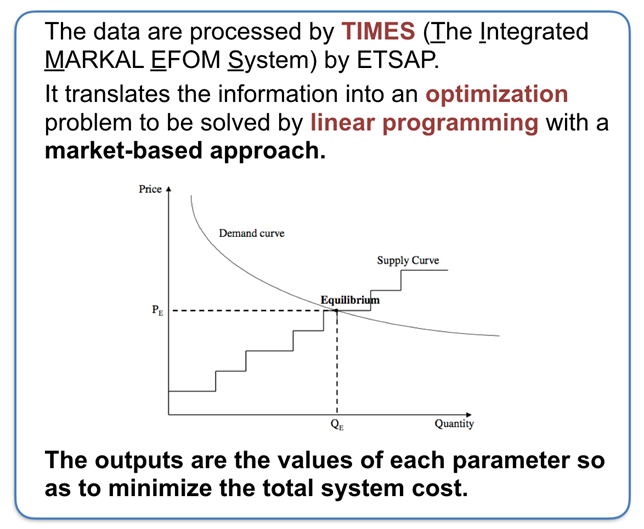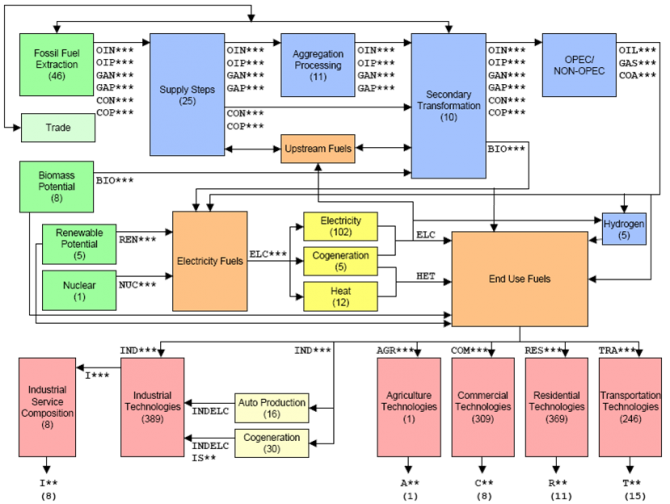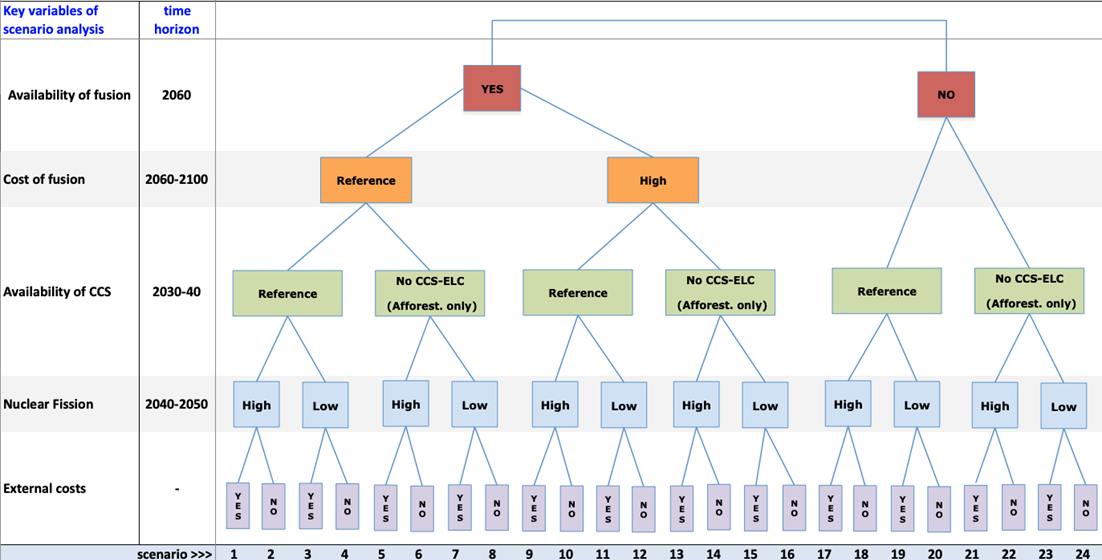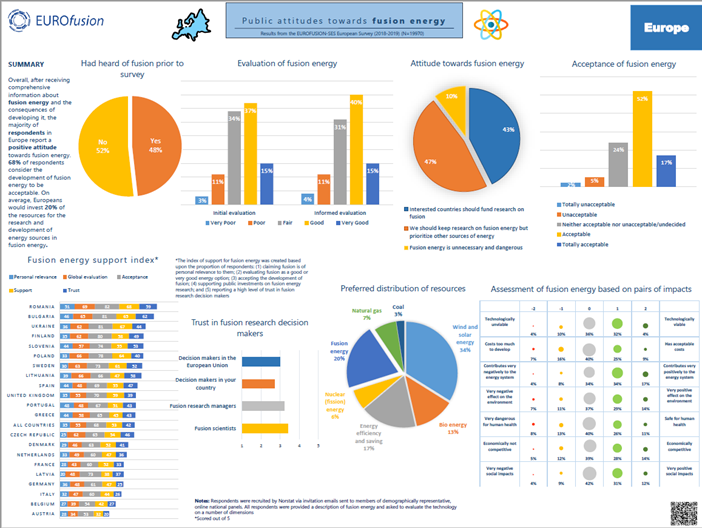Achieving nuclear fusion commercialization is a scientific and technological challenge that requires a never seen endeavour of the Scientific Community.
But many other factors may affect fusion success.
That’s why the EUROFUSION Programme includes Socio Economic Studies (SES) on fusion.
Since 2001, SES brings together the expertise of researchers in physical sciences, engineering and economic, social and environmental sciences to evaluate the economic and social aspects of the integration of fusion power into future energy systems.
Want to know more? Contact us!
Chiara Bustreo, ENEA/Consorzio RFX, Project Leader, chiara.bustreo@igi.cnr.it
Richard Kembledon, EUROfusion, SES Coordinator, richard.kemp@euro-fusion.org
Francesco Gracceva, ENEA, Economic Research Coordinator, francesco.gracceva@enea.it
Christian Oltra, CIEMAT, Social Research Coordinator, christian.oltra@ciemat.es
ECOMONIC STUDIES
1.1 ETM: THE MODEL OF A GLOBAL ENERGY SYSTEM
1.2 ETM MODEL REGIONS
1.3 THE REFERENCE ENERGY SYTEM
1.4 SOCIO ECONOMIC DRIVERS
1.5 SCENARIOS STORYLINES
1.6 PUBLICATIONS
SOCIAL STUDIES
1.1 RESEARCH ON PUBLIC ATTITUDES
1.2 STAKEHOLDER ANALYSIS AND ENGAGEMENT
1.3 MEDIA ANALYSIS
1.4 PUBLICATIONS
ECONOMIC STUDIES
Jump into the second half of this century when we expect to produce fusion electricity. Which economic, political, social conditions would effectively support fusion deployment? Let’s investigate the conditions affecting the current R&D programme to pave the way to fusion.
This is the task of a team of 10 researchers who are developing energy scenarios up to 2100 to gain insights on the evolution of the global energy system.

It depends on a variety of factors including the evolution of national economies, specific energy and climate policies, social behaviours and technology progress. SES energy scenarios are developed taking into consideration all the above aspects.
To this aim, SES has built the EUROfusion TIMES model (ETM); it translates the current energy system into mathematical equations to study its possible evolutions and its implications for fusion.
1.1 ETM: THE MODEL OF A GLOBAL ENERGY SYSTEM
The EUROfusion TIMES Model (ETM) is an economic model of the global energy system based on the Integrated MARKAL-EFOM System Framework, TIMES. The development of the ETM within EUROfusion started in 2004.
The TIMES economic model generator is a technology-rich tool, intended for the investigation of local, national or multi-regional energy systems evolvement over a long time period.
The model time horizon covers the time range from 2005 (the base year) to 2100 and assumes that from 2050 on fusion power plants are likely to be ready for the market.
The EUROfusion TIMES model ETM is specifically designed to explore the role of fusion technology in a future energy market and identify which parameters affect its market competitiveness.
The model setup is defined by a list of energy carriers and technologies involved in each sector of the energy system (upstream, industry, residential-commercial-agriculture, transportation and electricity and heat production). The complex of these factors results in the Reference Energy System (RES) sketched in the box. Specific technological and economic assumptions for each technology, region and year, and their corresponding environmental emissions are provided.
ETM actually models multiple energy markets, sector per sector, based on the general equilibrium theory, where a perfect competition among commodities is assumed, and in case of market imperfections where namely taxes, subsidies and hurdle rates, are exogenously defined.
The objective is the identification of the energy system configuration in each model region over a certain time horizon, so that to minimize the total Global System Costs, while satisfying all given constraints (e.g. socio economic drivers evolutions or CO2 emissions limits or specific technology availability).
1.2 ETM MODEL REGIONS
In ETM, the world is classified into 17 regions which are modelled separately although connected via trade processes of commodities (like coal, natural gas, oil, biomass, electricity, heat).
The ETM regions group single countries, which represent comparable conditions in terms of economical development.
| ETM REGIONS AFR Africa AUS Australia BRA Brazil CAC Central Asia & Caucase CAN Canada CHI Mainland China EUR Europe IND India JPN Japan MEX Mexico MEA Middle East ODA Other Developing Asia OEE Other Eastern Europe OLA Other Latin America RUS Russia SKO South Korea USA United States |
The regional energy-characterization (energy demand, energy resources) is based on IEA databases.
1.3 THE REFERENCE ENERGY SYTEM
In order to model the entire global energy system and its possible future development in ETM a reference energy system (RES) has been identified, which covers all available energy conversion technologies. All relevant commodities and processes have been identified and classified In a bottom-up approach.
The numbers in brackets indicate the amount of technologies considered per area. More than 1400 individual technologies are modelled.
Acronyms of the relevant commodities (e.g fuels or electricity or emissions) are indicated along the links of the RES. The total amount of distinct commodities exceeds 100.
In each region, 42 demand segments cover five end-use sectors: residential (11 segments), commercial (8 segments), agriculture (1 segment), industry (8 segments) and transportation (15 segments). Each demand segment is serviced by end-use technologies, whose number varies depending on the segment, as indicated by the figures within brackets in each box. These figures indicate the number of existing and future technologies available in each sub-sector.
1.4 SOCIO ECONOMIC DRIVERS
Each scenario is based on a set of coherent hypotheses on the trajectories of a number of socio-economic drivers.
Each socio and economic driver has been rated in terms of importance and level of uncertainty. The investigation has lead to the identification of a few critical drivers around which three scenario storylines have been developed.
Click on the graph to visualize the assumptions on the socio-economic drivers evolution in each ETM region .
1.5 SCENARIOS STORYLINES
According to the standard procedure of scenario analysis, that foresees the formulation of descriptive framework from which scenarios are developed, three storylines have been obtained from the combination of socio economic drivers, depicting pessimistic, optimistic and intermediate futures up to 2100.
| Storyline | Description |
HARMONY |
A world of strong environmental responsibility (low elasticity of energy service demands to their drivers). Operators take a long-term view when deciding their investments (low technology specific hurdle rates (HR)). A very stringent global carbon emissions (CO2) target is agreed and different world regions cooperate. |
PATERNALISM |
A world of mixed environmental responsibility (regionally differentiated elasticity of energy service demands to their drivers). Operators take a medium-term view when deciding their investments (medium HR). A very stringent global carbon emissions (CO2) target is agreed and different world regions cooperate. |
FRAGMENTATION
|
A world of weak environmental responsibility (high elasticity of energy service demands to their drivers). Operators take a short-term view when deciding their investments (high HR). A range of regional partial agreements on carbon emission (CO2) targets and (geo)politically constrained energy trade exist. |
Several alternative scenarios can be derived from each storyline, each showing different possible World with nuclear fusion playing different roles. The scenario tree shows an example of different possible combinations.
Scenario tree:
1.6 PUBLICATIONS
SOCIAL STUDIES
SES social studies focus on measuring the public opinion on fusion, collecting relevant sociological knowledge related to the acceptability of fusion as a contribution to a sustainable energy future energy source, and on identifying guidelines for a proper dialogue with society.
2.1 RESEARCH ON PUBLIC ATTITUDES
The scientific challenges of fusion science and technology are not automatically felt as beneficial to society, which holds back public effort in understanding and getting informed opinions. EUROfusion takes, thus, seriously societal awareness of its activities and the extent to which they are regarded as acceptable by the public.The social studies on fusion are focused on understanding the public and the stakeholders opinion on fusion, collecting relevant sociological knowledge related to the acceptability of fusion as a contribution to a sustainable energy future energy source, and on clarifying ways to contribute to a proper governance of the fusion effort
The origins of the study of public attitudes of fusion energy may be traced back to the publication of a European Commission (EC) report in the early 1990s (FPEB, 1990). That report identified the need for a better understanding of the social and economic issues concerning fusion research and development. Among the report’s conclusions was the recommendation that: “…adequate funds must be immediately allocated to ongoing studies on social acceptability in order that the evolution of opinion finds reflection in the orientation of research”.
In line with this recommendation, social research on fusion has been intended to provide the fusion community with a better understanding of the external conditions under which fusion plants, once available, might become economically attractive and socially acceptable.
Work on public attitudes in the last years has been aimed at investigating various psycho-social dimensions such as awareness of fusion, attitudes towards siting, place and identity, perception of risk, basis for understanding by different social groups or lay reasoning about new information in multiple contexts. The has been addressed in a number of both qualitative and quantitative studies.
In 2015 a dedicated section on public attitudes towards fusion energy was included in the SCK•CEN Barometer in 2015, which served as a large scale pilot study in preparation of a subsequent multi-national survey for investigating public acceptance of fusion energy research in Europe and examine the key determinants of lay attitudes to fusion. The SES cross-national survey was launched in 2018; it’s an online survey, conducted on nationally representative samples (N = 900 per nation) from 21 European, first of this kind at such a large scale. The first results from the questionnaire concentrate in a comparative analysis on cross-country and other group differences in self-reported measures of perceived benefits and costs, positive and negative affect, attitudes, acceptance and support of fusion energy research. Future longitudinal research will provide the evidence needed to examine the trends of public acceptance of fusion energy.
Contact: ana.prades@ciemat.es, christian.oltra@ciemat.es
2.2 STAKEHOLDER ANALYSIS AND ENGAGEMENT
Stakeholder engagement describes the process by which an organisation involves people who may be affected by the decisions it makes, or can influence the implementation of its decisions. They may support or oppose the decisions an organization takes, be affected by those decisions in the long-term, be influential in the organization or within the community in which it operates, or they may hold relevant positions in industry or government (Weston et al., 2014).
Stakeholder engagement has been among the main research areas within the social studies in fusion. Empirical work in this area includes a number of projects carried out at the community level (such as the studies around the siting decisions related to ITER in Porto Torres (Italy), Vandellós (Spain), and Cadarache (France) during 2001-2003, and a number of more recent consultations and dialogues with stakeholders and key informants (“informed audiences”) at the general societal level.
The key challenge today is the identification and implementation of the most suitable stakeholder engagement options. A wide range of methodological options and research tools have been investigated for generating stakeholder engagements processes around fusion.
Based on the outcomes of the SES research, an Expert Survey on the possible role of fusion energy technology in the future global energy system reflection group was started in 2018. The stakeholders’ consultation was organised as a first round with open questions implemented in an online tool with a selected number of invited experts. First assessments of the results show that the responses express a diversity of views related to energy policy matters, presumably based on the different backgrounds and social roles the experts. The research will be implemented in 2020, by adding a number of experts to the participants list, who will be asked the same set of questions.
Contact: gaston.meskens@sckcen.be
2.3 MEDIA ANALYSIS
Can media influence the dialogue between science and society? The original message can be intensified, weakened and/or filtered in some ways as media are not just neutral intermediaries of information: they can modify the information in the process, and this might influence the recipients of their messages.
Let’s focus on the energy sphere and in particular on fusion energy research.
The aims of the SES empirical social research on fusion-related media analysis are:
- Gaining more insight into the public understanding of fusion technologies,
through studying the media framing of these nuclear technologies, in all classic printed media, such as newspapers, the internet, and the social media. - Developing ‘communication tools’ in order to contribute to the quality of the public debate on nuclear fusion technologies.
One of the general objectives of WPSES in this period concentrates in gaining more insight into the public understanding of fusion technologies through studying the media frames of these nuclear technologies in both classic news media, such as newspapers in selected countries, and social media. A recent analysis of articles on nuclear fusion printed in German newspapers and magazines in the years between 2010 and 2018 in respect of an indicator of public perception – the metaphorical use of the term “nuclear fusion” shows that fusion research today is more present in public perception in Germany than in the past and that the general audience today is quite familiar with the meaning of “nuclear fusion”.
An investigation of the penetration of fusion research on the blogging platform of Twitter started in 2019, to explore how fusion is perceived, reported, commented on a cross-country analysis. A quantity and quality study of the top 200 samples of the most-retweeted Twitter data, in 8 European languages, reporting the words “nuclear fusion” is underway and will be further developed in 2020.
Contact: ana.delicado@ics.ulisboa.pt
2.4 PUBLICATIONS
Articles
| Year | Paper | Authors |
| 2020 | Fusion energy: A deeper look into attitudes among the general public. Fusion Engineering and Design, 161, 111891. | Turcanu, C., Prades, A., Sala, R., Perko, T., & Oltra, C. |
| 2015 | Executive Summary of the socio-economic research on fusion activities with stakeholders | Meskens, G.; |
| 2015 | Media analysis of fusion Executive Summaries for EUROFUSION | Schmidt, L.; Horta, A.; Pereira, S.; Oliveira, C.; Prades, A.; Oltra, C.; Sojak, R.;Afeltowicz, L.; Stankiewicz, P.; Milch, I.; Sieber, J.; |
| 2015 | A content and thematic analysis of the presentation of nuclear fusion on the Internet | Christian Oltra, Ana Delicado, Ana Prades, Sergio Pereira and Luísa Schmidt |
| 2014 | The Holy Grail of energy? A content and thematic analysis of the presentation of nuclear fusion on the Internet, Journal of Science Communication | Christian Oltra, Ana Delicado, Ana Prades, Sergio Pereira and Luísa Schmidt |
| 2011 | Investigating the degree of stigma” associated with nuclear energy technologies: a cross-cultural examination of the case of fusion power. Public Understanding of Science , pp. 1 -19 | Horlick-Jones, T., Prades, A., Espluga J |
| 2010 | Pilot multi-method study to explore evaluation options of the Fusion EXPO travelling exhibition Findings from Spain | Prades, A.; Horlick-Jones, T.; |
| 2008 | Lay perceptions of nuclear fusion: multiple modes of understanding, Science and Public Policy 35 (2), pp. 95 – 105 | Prades; A.; Horlick-Jones; T.; Oltra; C.; Solá; R. |
| 2008 | Investigating lay understanding and reasoning about fusion technology | Prades; A.; Horlick-Jones; T.; Oltra; C.; Navajas, J.; |










